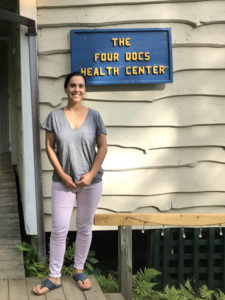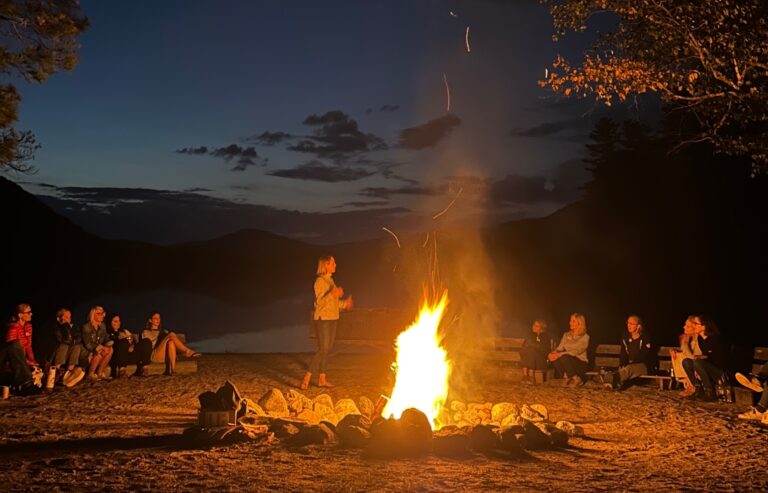- Newsletters 2019
- Resources for Parents
- Summer 2019
#7: Setting the Standard
2019 Newsletter Number 7
[This week’s letter comes from Associate Director Kenny Moore]
On Tuesday, August 6, two visitors from the American Camp Association (ACA) spent the day at Camp Pemigewassett as part of our regular accreditation process. Every five years, we host an official visit to share our policies and procedures with the ACA. The national organization sets forth industry-accepted and government-recognized standards and accredits more than 2,500 camps throughout the country. ACA visitors are all camp professionals who volunteer their time to ensure that camps across the country are following the best practices in the camping industry. Five years ago, I became an ACA visitor, which provided me with a wealth of knowledge about the accreditation process and also the camp industry as a whole. We can gain so much from sharing our ways of doing things with like-minded peers and learning about similar institutions.
Just this past winter, the ACA revised their accreditation standards in an effort to streamline the process and to better meet the needs of camps in the present day. The new organizational scheme is broken down into seven sections, each with a primary focus on the operations of a camp. These apply not only to residential camps but also to day camps, short-term camps, summer programs at schools, and vendor groups using camp facilities. Here are the seven sections:
CR – Core/Foundational
AD – Administration
FA – Facilities
HW – Health and Wellness
ST – Staff Qualifications, Training, and Supervision
PD – Program Design and Activities
PA – Program Aquatics
In total, these sections list one hundred and seventy-six standards, many of which have multiple components. For each standard, there are a few ways to demonstrate compliance. The ACA stipulates whether written material is required or, alternatively, an observation from the visitor or a discussion of policy from the Camp Director. For example, CR.5 – Conditions of Facilities, Equipment, and Vehicles – “Are buildings, structures, grounds, equipment (including vehicles, if applicable) and activity areas maintained in good repair, and kept clean, safe, and sanitary?” Our description of our maintenance procedures and the visitor observation covers this standard.
Or AD.5 – Transportation Information for Parents – “Are parents or guardians of campers who are transported to/from camp provided written information? (Written documentation required).” We share materials and our transportation information as found in the Parent section of our website along with our safety rules for van/bus travel. This demonstrates compliance. There are some standards that ‘Do Not Apply’ to Pemi, such as PA.7 Swimming Pools (our lake does just fine for swimming and boating, thank you) or PD.16 Pony Rides (and we haven’t had horses here since the 1930s). These are scored as DNA.
The accreditation process starts early in the spring when Elizabeth Snell, the New England ACA Standards Coordinator, contacts Danny and me. She connects us with two other camp professionals to schedule an official visit day later in the summer as well as a pre-visit to get the ball rolling. The pre-visit includes thirty-five standards that are either scored by written documentation or Director interview, most of them falling into the Administration category. In April, Danny met with our visitor and shared our policies covering these standards.

Also in April, our wonderful administrative coordinator Kim Malcolm began to organize Pemi’s personnel and materials for the official visit. Kim has successfully guided Pemi through multiple ACA visits over the past few decade, and we are incredibly lucky to have her spearheading our efforts. Adding to this year’s challenge was that, as I noted, the ACA updated their standards since our last visit in 2014. We all needed to spend time with these newly written and organized standards to be sure we understood these new requirements together with the new location of old standards.
Visit Day
While the accreditation process is a matter that technically involves only our staff, this year the campers got wind of what was going on and really took an interest. They know and love Pemi and wanted to be sure the visitors saw us for what we are. A signal that we were ready for our visit day came over loud and clear in the Mess Hall on Monday evening. In lieu of one of our traditional Tecumseh Day cheers, the crowd of interested boys excitedly chanted, “Na Na Na Na, Na Na Na Na, Hey Hey-ey ACA!” Each repetition was louder and quicker, adding palpable energy to the Mess Hall.
The tour on Tuesday morning started in the kitchen to check out Tom Ciglar’s operation in full swing. Visitors looked to be sure that the kitchen works in a clean and efficient manner. Tom showed us the walk-in-fridges, his dry storage, the dish-cleaning area, and the mechanical dishwashers, describing each and every process we use to ensure safety and cleanliness.
Next up at Buildings and Grounds, Reed Harrigan walked us through each of the bays of the maintenance shed, pointing out the locked cabinets containing hazardous materials as well as the electrical, water, and other utility maps that explain the infrastructural workings of Pemi. A quick trip then behind the shed, to see the Pemi fleet of vehicles—one school bus, four rental 12- or 15-passenger vans, and three rental cars, each equipped with a mileage log, fire extinguisher, first aid kit, and emergency flares.

Dr. Sabrina DeStefano toured our visitors through the Health Center, showing them the facility with the necessary secure storage for medications, our record-keeping process (thanks CampMinder!), and our quiet rooms for boys needing to rest and recuperate. After the Health Center, we visited Lower 1 to check out one of our permanent sleeping quarters. One of the visitors grabbed a broom and reached up to press the test button on the smoke detector, which beeped cooperatively in compliance. Then it was on up the hill to the Intermediate Shower House and Pagoda, to inspect one of Pemi’s bathroom facilities.
Next, we visited the Nature Lodge to hear Larry Davis discuss the Nature Program, most notably the Wild Foods occupation and the annual caving trip. (Larry, by the way, is a long-time ACA visitor himself, and is a wonderful asset to have in hand as we prepare to be visited ourselves!) Larry’s training and experience easily covered the requirements for both special programs. Brian Tompkins then showed us around the wood shop and its power tools, a place where safety is obviously paramount. Our visitors checked to be sure that guidelines were posted and that the operation followed them to a T.

The visitors then sat down with Kim and me at a picnic table in the sun to review the standards that we witnessed during our first walk-about. We positively cruised through the sections, as Kim had all of our paperwork arranged in precise order. When asked about our hiring policies (AD.24), Kim presents the documents explaining our process, starting first with our hiring checklist. “Here is the application for staff members, their reference checks, notes from their interview with one of the directors, and their results from the mandated background check.” Our visitors inspect each document, note that we are in compliance, and move on to the next standard. After an hour of paperwork, I take our visitors to observe a few more of our specialized activities.
Specialized Activities
The ACA defines a Specialized Activity as one that requires equipment or tools that necessitate supervision by a skilled adult. Archery, woodshop, hiking trips where cooking on the trail is necessary, or competitive sports where protective equipment is used (Lacrosse, Soccer, Baseball) fall into this domain. Our staff provides excellent supervision within all these activities either through their own experience in the field or through specific training.

At the waterskiing dock, Molly Malone explained how she runs her program, the use of lifejackets, and other aquatic safety regulations specific to her area. Chloe Jaques was teaching sailing from the safety boat as our visitors checked out the rules and safety guidelines for proper boating that were clearly posted in the Boathouse. At Senior Beach, Charlotte Jones discussed our process for classifying swimmers through our required swim check and also the buddy system we use for ensuring safety during Free Swim. On the Archery range, our visitors witnessed Steve Clare running the range in a safe, efficient manner, noting the correct use of equipment (in line with conspicuously posted rules), locked storage for bows and arrows, and documentation of the appropriate staff training.
The day was a tremendous success. ACA standards for accreditation allow for the taking of a few “No” answers to the hundreds of questions, but Pemi came away from this with nothing but “Yes’s”! Our visitors noted Kim’s complete understanding of the standards process, and in fact joked about hiring her away from us for their own camps’ next review. Pemi’s key operational areas—the kitchen, buildings and grounds plant, and the Health Center, all hummed along on an impressive level. We are so fortunate for their care, constant eye towards safety, and unfailing hospitality for all of us at Pemi. Moreover, our program heads demonstrated their extreme competency in running their areas in a safe and structured way that was, at the same time, fun and exciting. It was a true team effort across the board. You may not be surprised to learn that the boys, that evening in the mess hall, followed up on their earlier “Na Na Na Na” effort with a rousing chorus of “Perfect Score!”
–Kenny
[That’s it for now. We look forward to getting back to you next week with Danny’s season-summarizing Toast from Thursday’s Final Banquet and the legendary Clive Bean’s review of The Mikado, which opened last night in the Pemigewassett Opera House.]























































